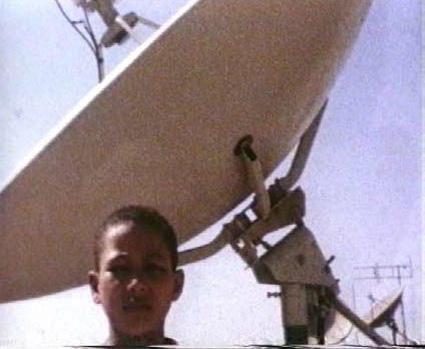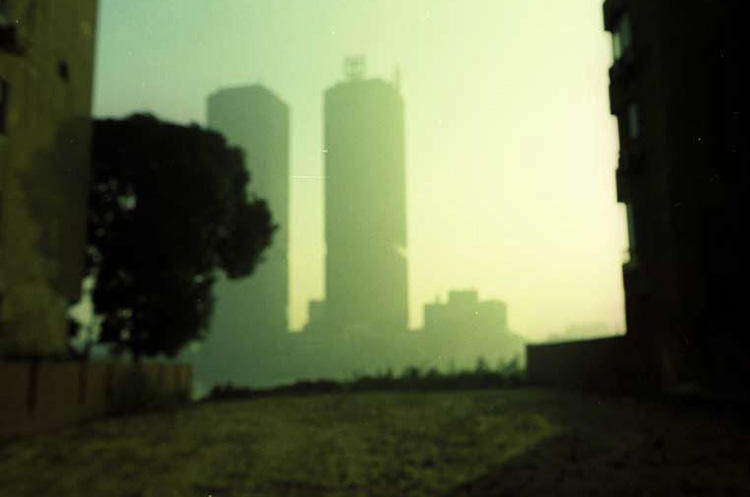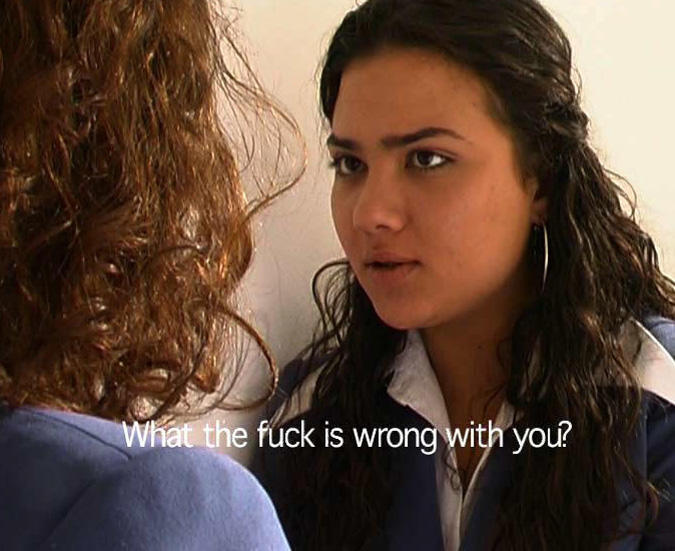
Courtesy of the artist
Sherif El-Azma’s career up to this point, as an artist and experimental filmmaker, is bookended by two works that are formally very different but, thematically, seamlessly connected. On one end is Order in Satellite City (1997), a short piece shot on lusciously grainy Super 8 film. On the other end is The Psychogeography of Loose Associations, a live performative lecture that positioned the artist behind his audience, narrating a text while images, photographs, statistics, and videos were projected onto a screen up front. Maurice Luca, one-third of the electronic music group Bikya, contributed live sounds while Nermine al-Ansari, using an electronic pen, produced live drawings of urban grids and other seemingly random doodles and notations.
The lecture unfolds like the presentation of research findings regarding the casual formation of informal psychogeographical societies in Cairo. Azma finds, or imagines, these societies to be leisurely, recreational affairs. (The term psychogeography was, if not exactly coined, then at least memorably defined in 1955, by Guy Debord, as the study of how cities are organized and of how their various levels of organization affect individuals who live and work in them, move through them, use them, and explore them.) Though many contemporary psychogeographical societies are directly inspired by Debord and the Situationist International, the groups of Azma’s study are more straightforward hobbyists, weekend warriors, and urban explorers; their activities have more to do with practice than with theory. For about an hour, The Psychogeography of Loose Associations, which Azma has been touring since 2007, accumulates thoughts and textures—and then it disappears. Like Order in Satellite City, it considers the shifting urban arrangements of contemporary Cairo and the mechanisms that structure people’s lives, from state surveillance to satellite television.
To a certain extent, Order in Satellite City diagnosed a condition, and The Psychogeography of Loose Associations picked up where it left off, prescribing—without ever being overt about it— a kind of cure. Azma carefully resists the heroic but with great subtlety pushes for an experience of the city that involves carving a poetic path, seemingly aimless and unfettered by impositions or constraints. He deciphers ordering systems, it seems, for the purpose of circumventing and, finally, escaping them.
“If you had a psychogeographical society in Cairo,” Azma asks, “how would it function? Do you have the authority to survey the city? In a way, this is tied to the state security and paranoia of the 1960s, and [the impossibility of] going around collecting traces and not getting caught. If you have a psychogeographical society in Cairo, they’ll come find you, because what are you looking for? Years ago, New Cairo, which are now wealthy suburbs, were no-go zones. They were military zones, paranoiac zones, and you could not enter them. The military is less than it was since 1973. With the notion of psychogeography, I use it as an excuse to look at how institutions are built, how institutions network, and how people become institutions. It’s more about systems, really. It’s fun to play with the idea of psychogeography, because it’s a form of playing with the city more generally.”

Courtesy of the artist
What is strange, then, is that the slew of works that came between Order and Psychogeography might well be the output of another artist entirely. With only a few exceptions, his works from that ten-year stretch are all videos, all tethered to television (as a subject, a flatness of surface, or a format, such as the soap opera), and all concerned, in a major way, with gender and class more than urbanism.
Considering the arc of Azma’s creative output, one can detect in its shape the story of video art in Cairo, the story of the city’s independent art scene. Works such as Fish Soup and A Prayer to the Sound of Dogs (both 2001) have the messiness and playfulness that characterized experimentation with the medium when it was almost hopelessly low tech, and when artists had yet to formalize their styles or their visual codes.
Not surprisingly, Azma was one of nine artists who participated in Transit Visa, a video workshop organized by Akram Zaatari and Mahmoud Hojeij back in 2001 in Beirut. Fish Soup, a one-minute video, was made for that occasion. Borrowing a slogan prominent in South Lebanon at the time (“We do the liberation, you do the reconstruction”) it imagines the country’s political condition as an amorous encounter, though the Lebanese specificity of the situation is amusingly undercut by a voiceover recorded in heavy Egyptian slang. “What if Hizbullah was a guy and Lebanon was a woman, and they met on the street in a solicitous way?” Azma asks, revisiting this and other examples of his work. Fish Soup shares a certain exuberance and an enthusiastic testing of visual effects with Zaatari’s early videos, such as Red Chewing Gum, How I Love You, and Crazy of You, and with Hojeij’s Shameless Transmission of Desired Transformations Per Day. It is also, like those videos, among the few artworks from the region to treat (or even allude to) sexuality as a subject.
A Prayer to the Sound of Dogs illustrates why such works remain so few in number. One of the first works ever banned by state censors while it was on show at Cairo’s Townhouse Gallery, it was attacked by the local press for being pornographic. “It was a weird time for video,” says Azma. “The art scene was so young, video was so young. I think it confused people. I was considered this feminist director,” after his video Interview with a Housewife (2000), which he ruefully describes as “the all-time curator favorite.” But some considered A Prayer to the Sound of Dogs excessively macho. “I felt I had to look at myself and my complexes and desires,” he says. “I wanted to do something with young men. I wanted to explore the line between homosexuality and homoeroticism, which is a very fine line in Egypt. I also wanted to explore the line between being a super-bitch and a liberated woman. But with censorship, you can attack people two ways: through politics or through sex.”
The press chose the latter, and to make matters worse, Azma was out of the country at the time the show featuring his work was shut down. A Prayer to the Sound of Dogs was shown publicly only once, which is a shame, really; it’s far from pornographic. The piece is actually a surreal rumination on the performative aspects of identity, gender, and class. One female character, Doa, discovers the handbag of another female character, Marwa, and by degrees Doa imagines the life of Marwa, befriends her, and becomes her. Toward the end of the video, Azma opens the seams of the work and reveals the process of making it in a rip-roaring fight between director and actress, questioning the mechanisms of control involved in the creation of an artwork. Few artists have been so brave in laying bare these kinds of conflicts, which are nonetheless inevitable in any practice.
Azma may be one of the foremost practitioners of video within Cairo’s independent art scene, but still, he works firmly outside even that system. He says he fails to understand why anyone would show a video or a short film in a stand-alone art space rather than cinema-style, on a screen with a seated audience. He keeps to himself and occasionally drops off the scene entirely (there are gaps in that bookended decade). He’s a solitary person, self-effacing, a bit of a loner. He doesn’t actively promote his work. He’s far from prolific. And he prefers teaching classes in experimental film at the American University in Cairo to committing everything to his art. “I would go crazy if I were an artist full-time,” he says.
Interview with a Housewife and Pilot for an Egyptian Air Hostess Soap Opera (2003) are arguably Azma’s best-known works. The latter, which screened at the second edition of the Home Works Forum in Beirut, is nearly an hour long and something of a masterpiece. It features four young women at the outset of a training program for a fictional airline. The initial sessions make clear that the environment fostered by this bland and literally whitewashed multinational corporation will seek to “nullify local culture,” explains Azma, “and to manufacture a space where cultural signifiers are no longer present. So how do you de-sexualize and de-Egyptianize these women?”
Azma is almost preternaturally attuned to the bitchiness that can characterize relations among female colleagues; part of the genius of Hostess is the manner in which protagonists and antagonists shift their roles within a confined space. And it’s that, that attunement to shifting roles and relations, that links Azma’s genderand class-based melodramas, his claustrophobically flat videos, with his first Super 8 film and his last live performance. Like the flaneur who is never fully present in Order or Psychogeography, the characters in Hostess, in the more documentary-style Donia: Amar, and in the many as yet un-synthesized chapters of the so-called Kenya Tapes—a fragmentary work in progress that stems from a 2004 trip to Kenya and a series of workshops with actors and musicians—are all struggling with manners and methods of confinement.
For the Kenya Tapes, Azma constructed a fictional tourism company that is in the process of devising a marketing campaign, replete with logos and mission statements and uniforms and so on. But one of the company’s employees keeps wandering outside the dull white cube that is her office. She keeps drifting into a bizarre Technicolor landscape that periodically appears onscreen. She, like so many of Azma’s characters, cannot be contained. With this gesture, Azma takes an empty adage about thinking outside the box and makes it, for once, mean something.

Courtesy of the artist